DISCLOSURE: AS AN AMAZON ASSOCIATE I EARN FROM QUALIFYING PURCHASES. READ THE FULL DISCLOSURE FOR MORE INFO. ALL AFFILIATE LINKS ARE MARKED #ad
Update: I’ve tested the lens barrels again, and I can confirm that there is no sand trapped anymore. I can still change the zoom though (albeit with some resistance), even though the zoom lock ring is in the locked position.
I’ve wanted a super-telephoto zoom for my Panasonic GH5 for a long time since my longest lens up until now has been the Lumix 14-140mm.
So after going back and forth between the Lumix 100-300mm, the Olympus 300mm, and the Leica 100-400mm, I finally settled on the latter.
To sum up the three major selling points for me, they were image quality, reach, and versatility.
I’ll get back to all these points, and more in this review. So let’s dive in.
The Panasonic Leica DG 100-400mm in short
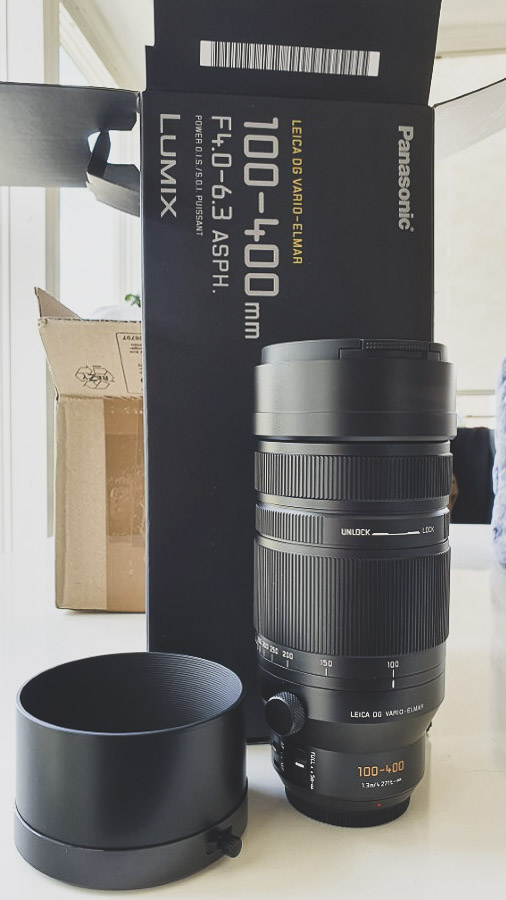
The Panasonic Leica 100-400mm f/4-6.3 is a weather-sealed super telezoom lens for the micro-four-thirds system.
Here’s a quick overview of its excellent features:
- A focal range of 100-400mm, which equals 200-800mm in 35mm full-frame systems.
- A variable aperture between f/4.0 (at 100mm) and 6.3 (at 400mm). The minimum aperture is f/22.
- Nine smooth rounded blades that create a nice bokeh.
- The coating creates nice flares.
- Splash and dustproof weather-sealed body
- Power Optical Image Stabilization (O.I.S) and compatibility with LUMIX Dual I.S. 2.
- Integrated rotary tripod foot and built-in sliding lens hood.
- Lens-mounted control switches for quick access to settings: Full/Limit focus range, AF/MF, and O.I.S.
- 240 fps high-speed silent AF-motor.
- Filter thread size is 72mm.
- Integrated zoom lock ring.
Those are the features I love and think should be emphasized, even though I do have some questions about the weather sealing. But I’ll get back to that in a minute.
For this review, I’ll just name it the PanaLeica 100-400mm or similar, but the full name is the Panasonic Leica DG Vario-Elmar 100-400mm F4.0-6.3 ASPH Power OIS.
Range
The range of 100-400mm gives this lens an equivalent range of 200-800mm on a 35mm Full-Frame sensor.
That’s an insane reach, especially considering the size and weight of the lens compared to full-frame equivalents.
To give you an idea of the range here’s a shot, I took with my smartphone a Samsung Galaxy s10e at normal settings (not the wide lens). It has a 12MP (1/2.55″) sensor and a crop factor of 5.62.
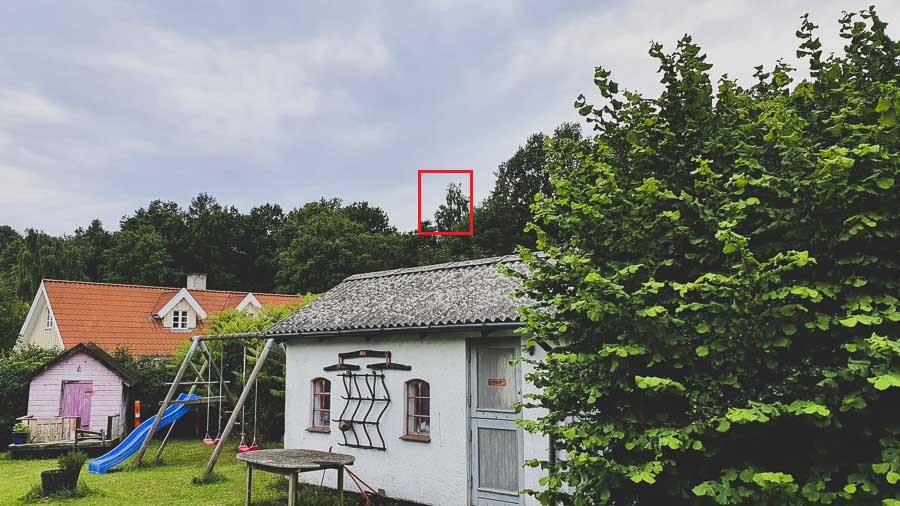
Notice the red rectangle? Ok. A few moments before, I had noticed this girl hunting from above:
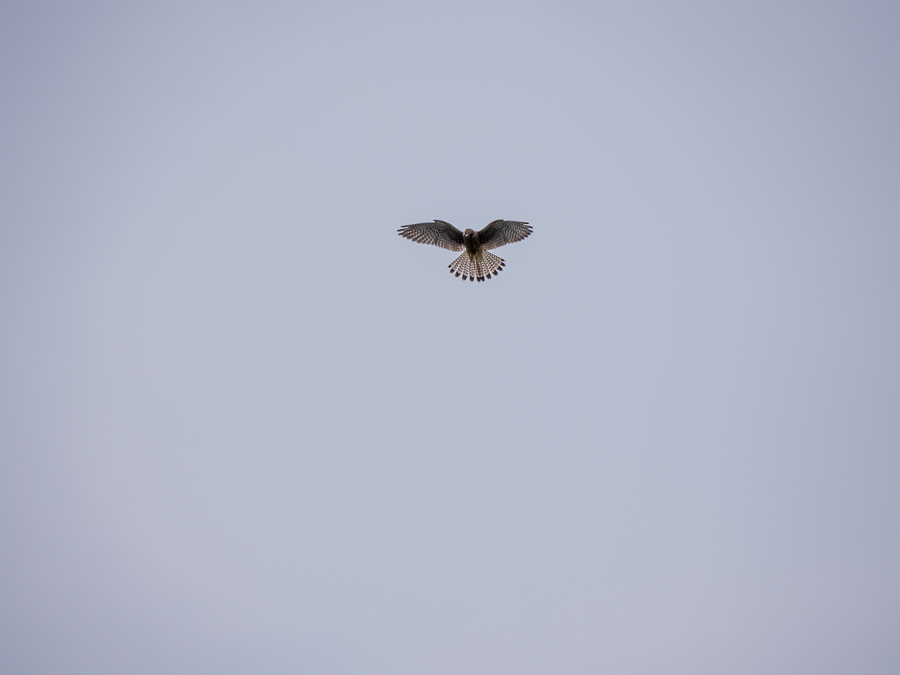
I saw it diving and fly to the top of the tree I’ve highlighted in the smartphone picture above.
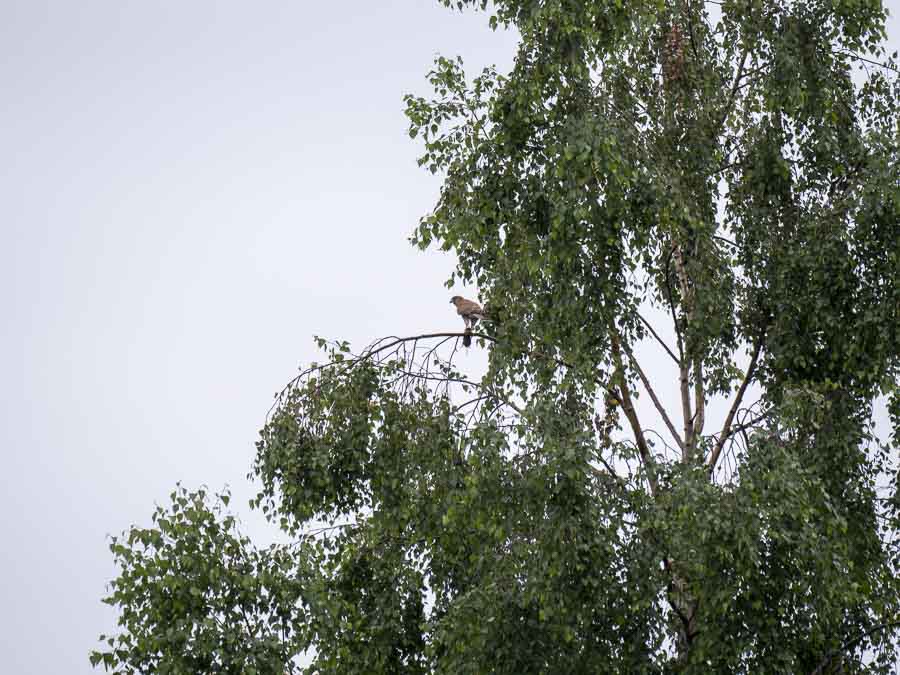
And it looks like it fond a nice prey.
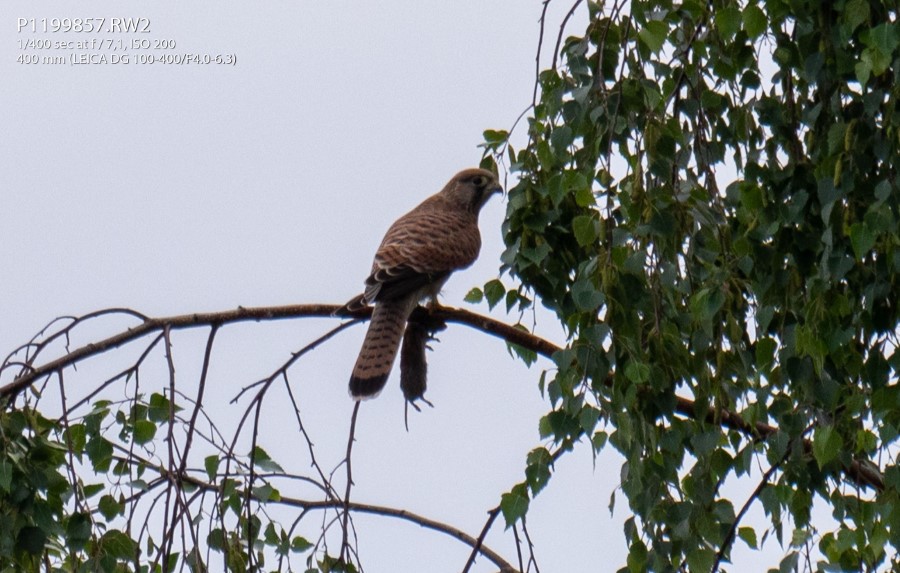
Size
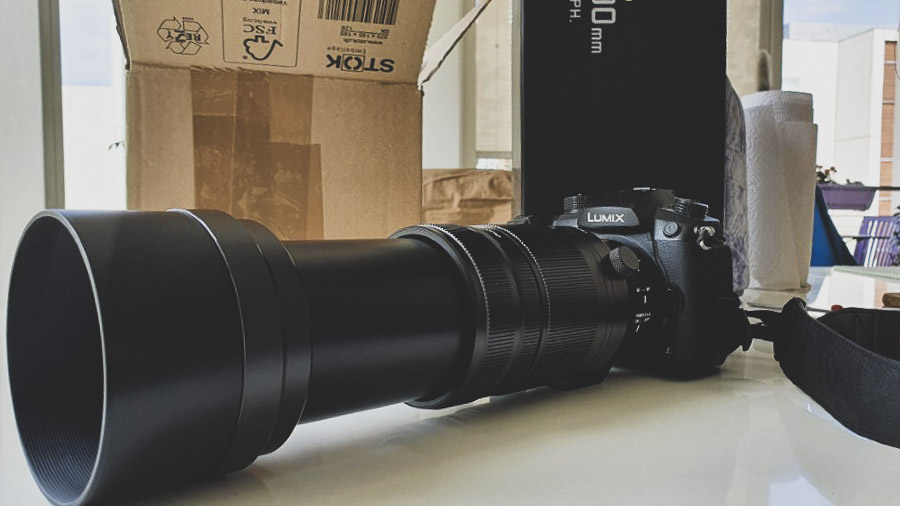
The lens only measures 3.27 x 6.75″ (83 x 171.5 mm) and weighs 2.17 lb (985 g).
For comparison the full-frame Sigma 300-800mm f/5.6 lens for Canon EF measures 6.16 x 21.42″ (156.5 x 544 mm) and weighs 12.9 lb (5870 g).
So to get this kind of reach and resolution in a lens this size is pretty incredible.
Optics
The Pana Leica 100-400mm is constructed of 20 elements in 13 groups and incorporates a number of aspherical and extra-low dispersion elements.
The maximum aperture is between f/4 (at 100mm) and f/5.8 (at 400mm), and the minimum aperture is f/22.
The iris has 9 rounded blades that makes some great looking bokeh.
And the incredibly clean and sharp image is good enough to earn it the Leica logo, which requires a high standard in terms of optics and image quality.
Image Quality
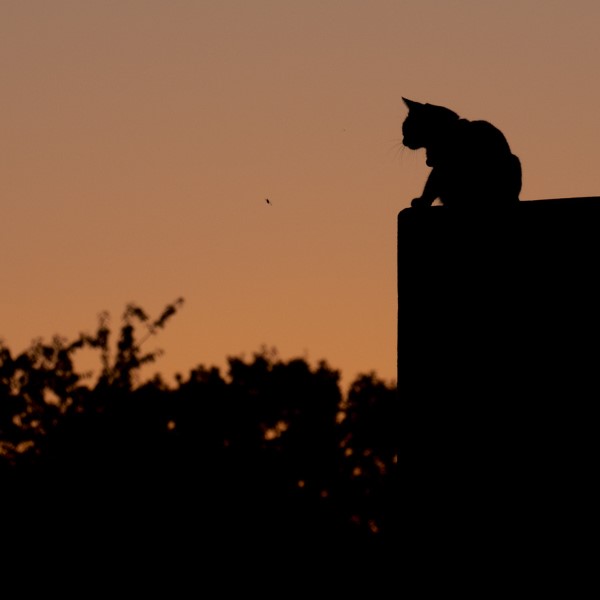
Let me start by saying that the image quality of the Panasonic Leica 100-400mm is outstanding.
The images I’ve been able to get from this lens are both sharp, clear, and has great color rendition.
When shooting into the sun, the lens also flares beautifully.
The lens does get a bit softer at 350-400mm, but it’s still a great looking image.
In fact, this was one of the reasons I ended up buying this lens instead of the Panasonic 100-300mm, which I found was too soft at 250-300mm and not as crisp and clear in general.
I really do love that extra range.
Below you can see a gallery of photos, I’ve shot with this lens.
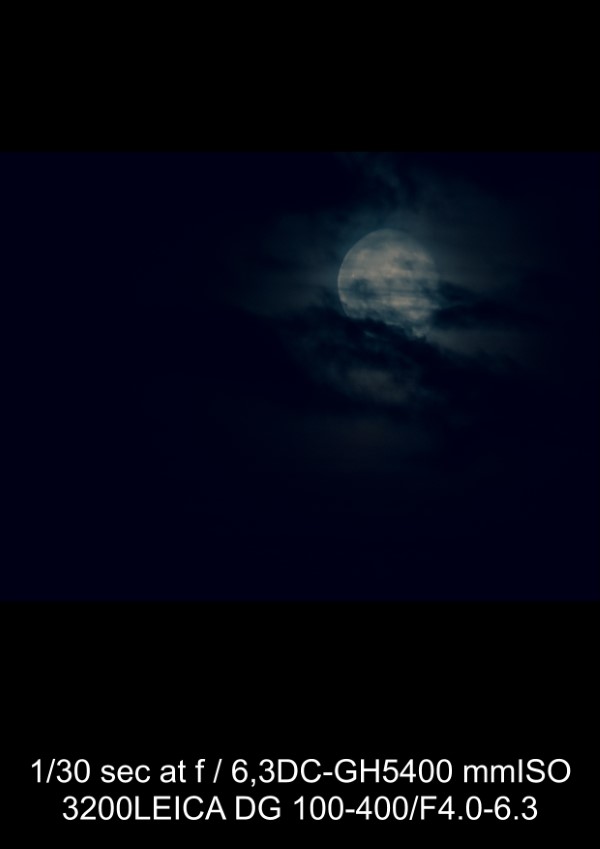
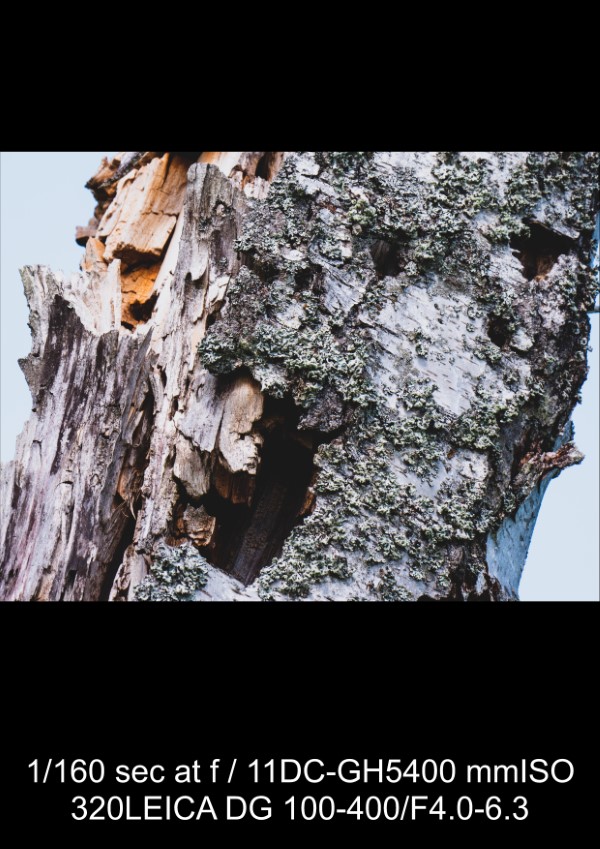

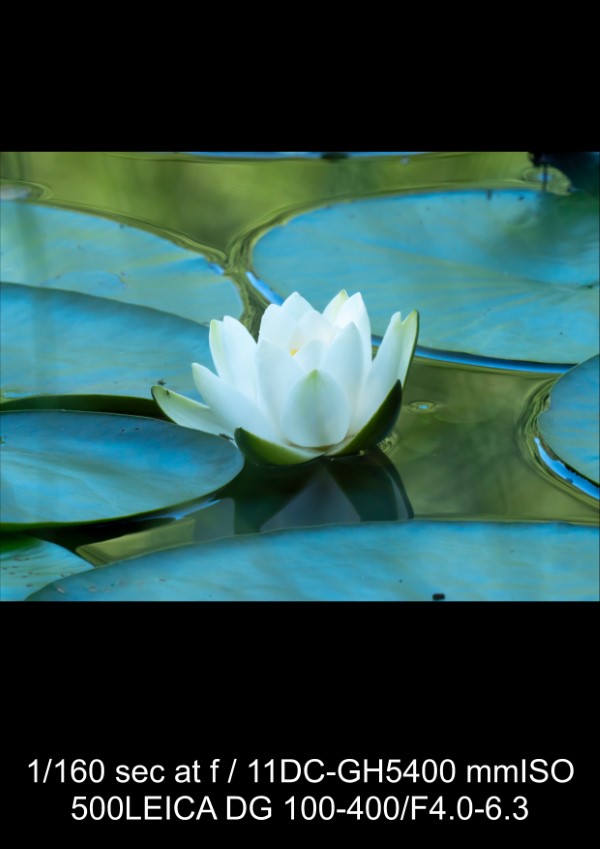

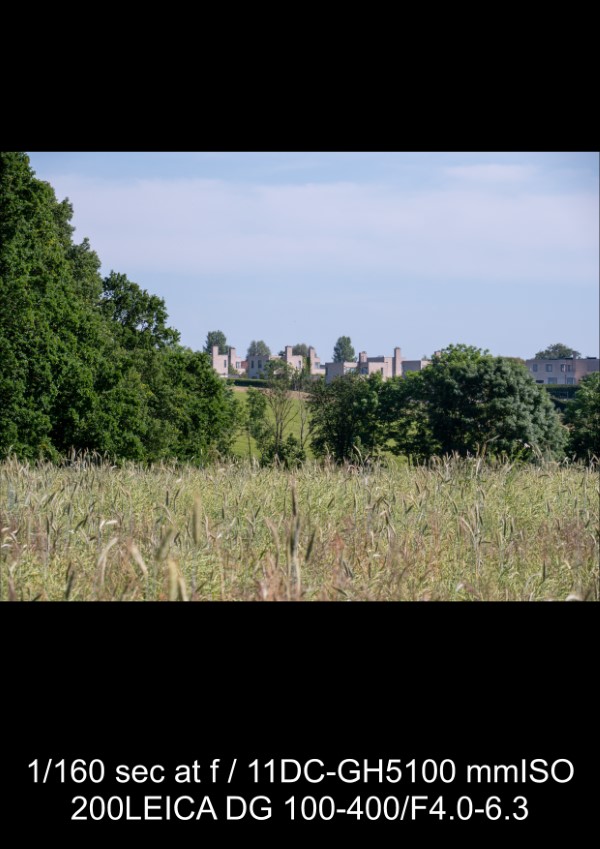
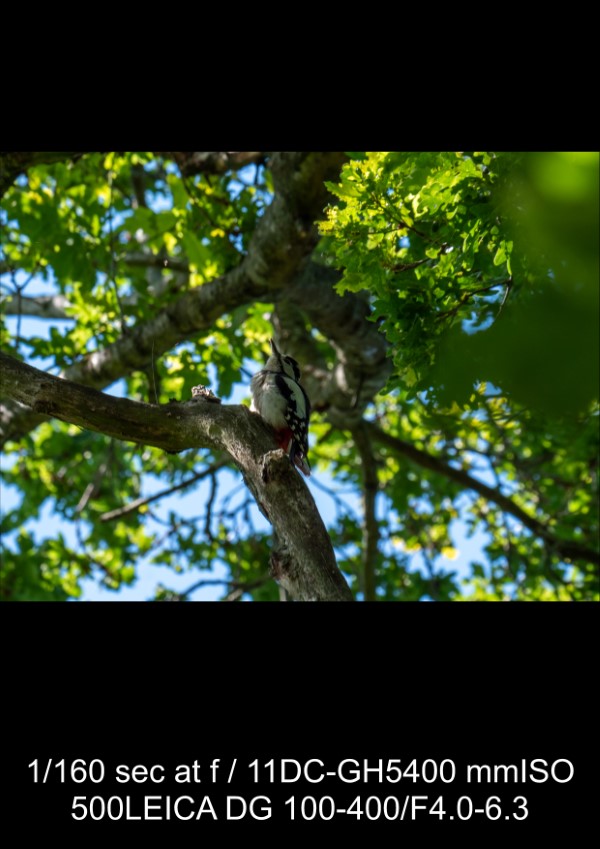

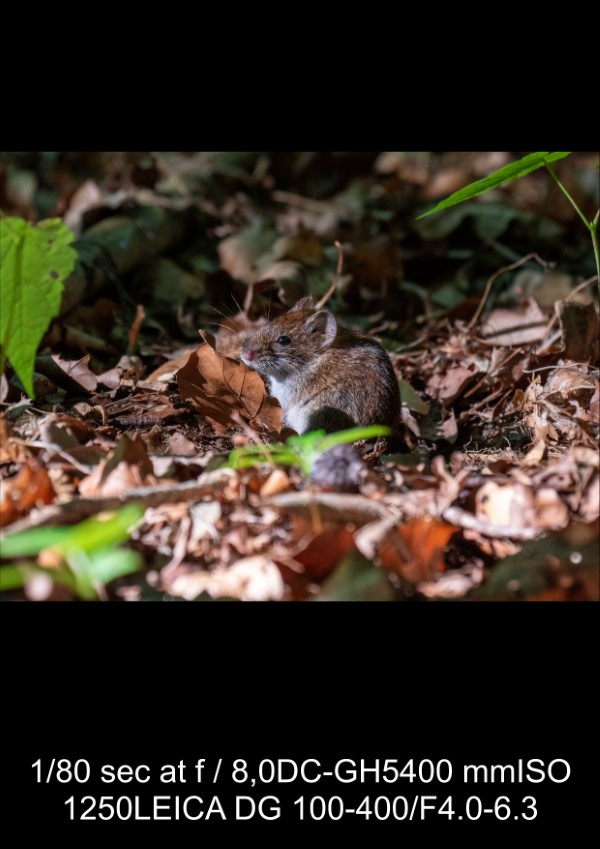
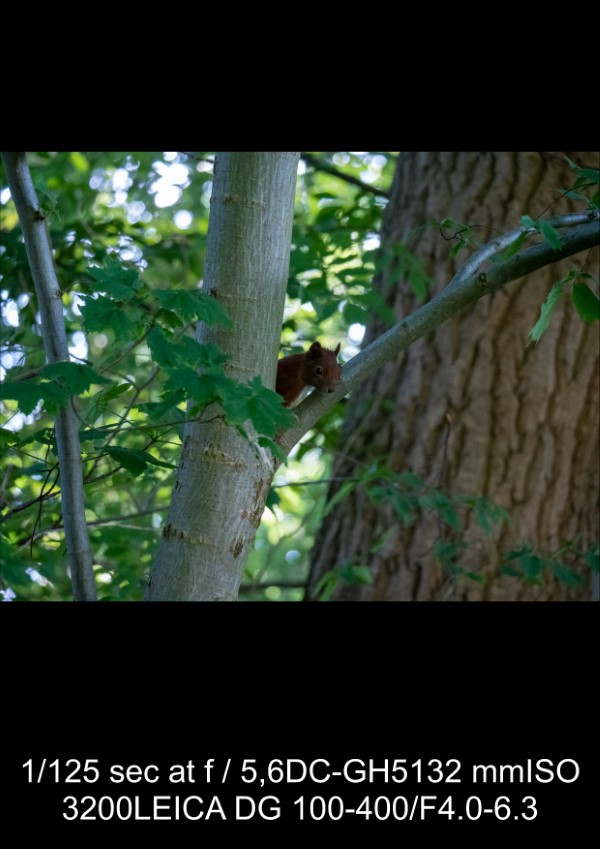
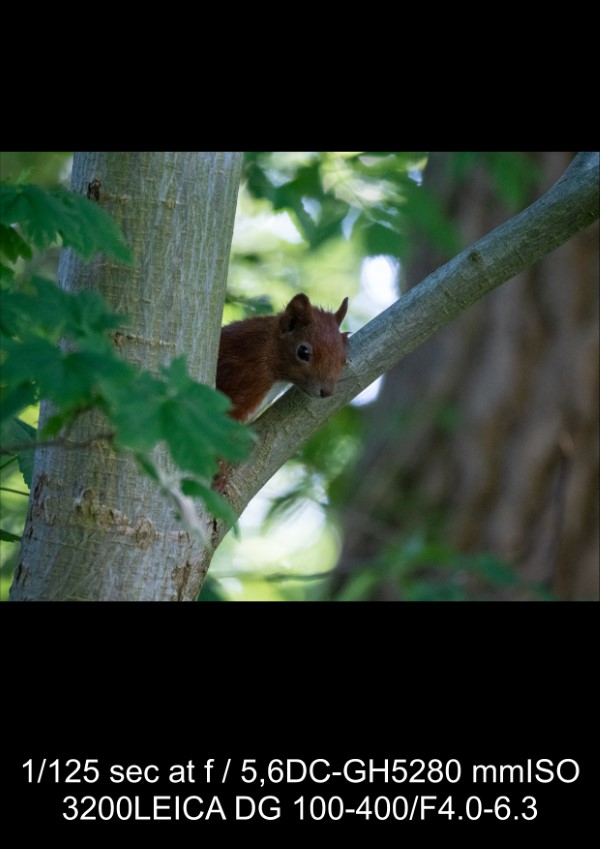
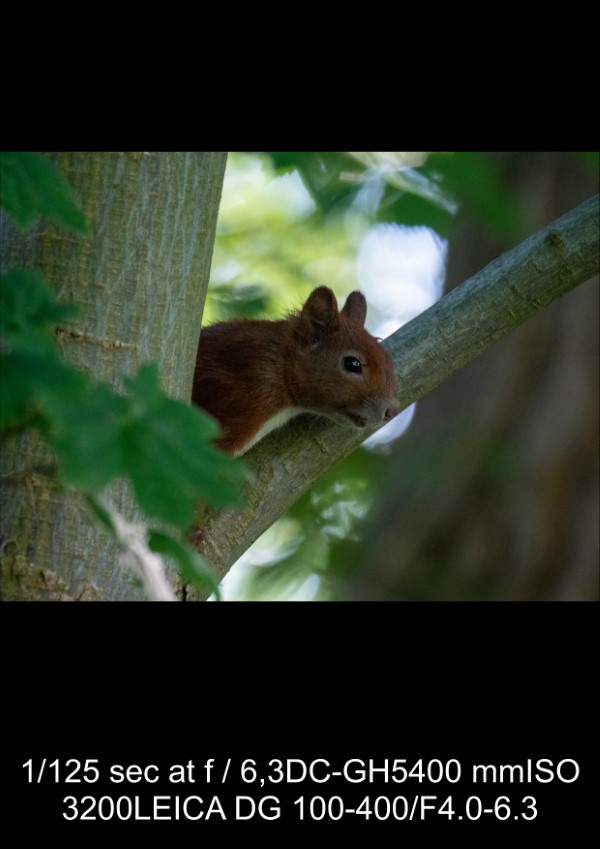
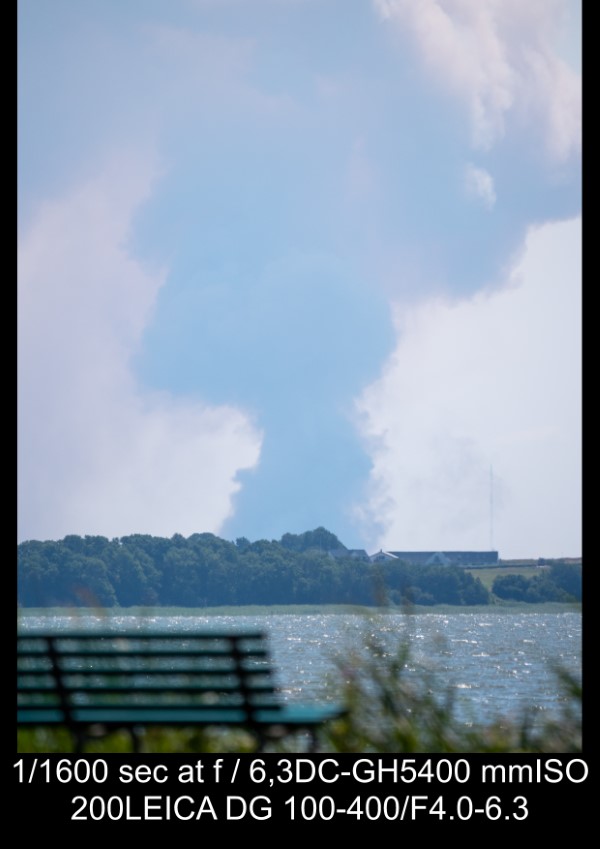
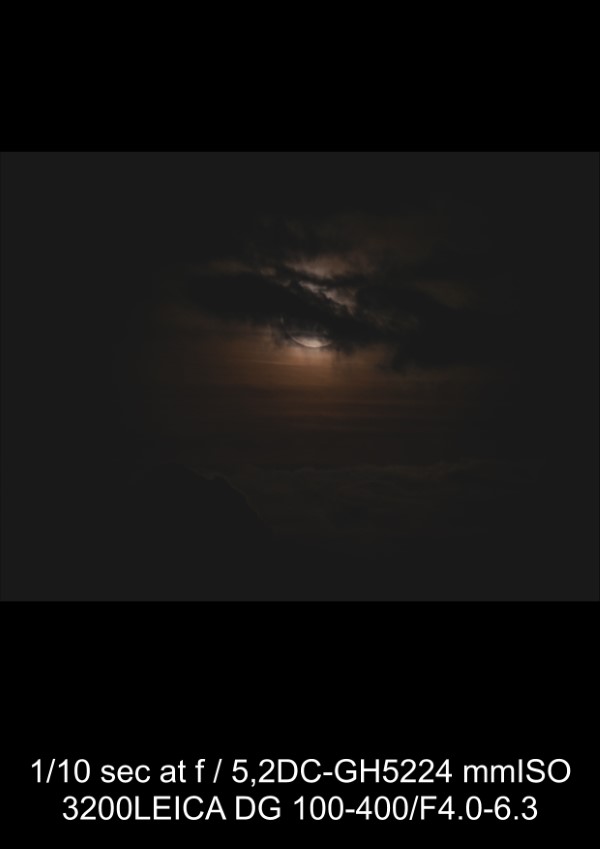
Image Stabilization: OIS and Dual IS 2.0
The lens also has in-built O.I.S. and supports 5-axis Dual IBIS 2 from Panasonic, which really comes in handy when you’re shooting handheld at longer focal lengths.
The In-Body Image Stabilization (I.B.I.S.) in the GH5 works in tandem with the Optical Image Stabilization (or Power O.I.S.) on the lens to create a 5-axis stabilized image.
This makes it possible to use up to five stops slower shutter speed at a focal length of up to 280 mm. Exactly how many stops this is an improvement above Dual I.S. v1.
Be aware though, that in order for Dual IS 2 to work you should use lens firmware version 1.1 or later, which you can download here.
Auto focus

The PanaLeica 100-400mm has a 240 fps autofocus motor for fast autofocusing.
I find that the lens focuses fairly fast although it does seem to hunt at bit at longer focal ranges between 300-400mm.
I would never trust it for continuous autofocus, but that has as much to do with the bad autofocus on the GH5 as it has to do with this lens.
The quick switches on the side of the lens allow you to change the focal range from full to 5m to infinity.
If you’re shooting subjects that are far away, I find that changing the setting to the latter speeds up the autofocus a bit when taking photos.
But I wouldn’t call the autofocus on this lens lightning-fast, especially not at the longer focal lengths where it seems to struggle.
Rotating Tripod Mount
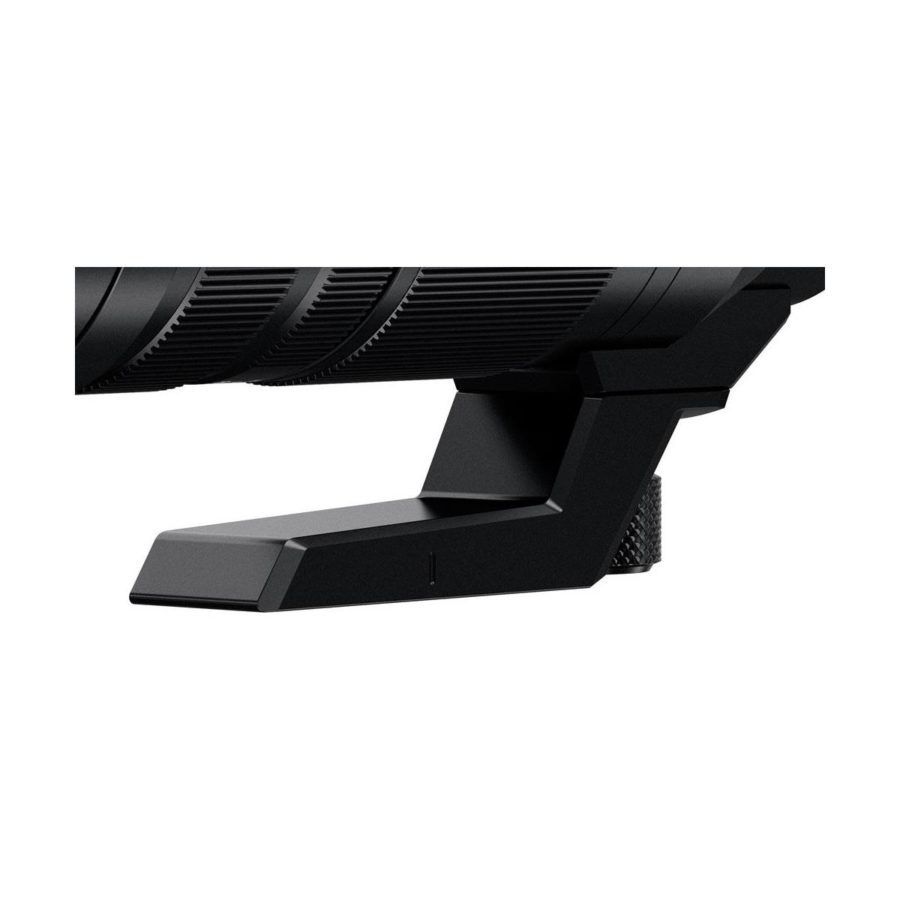
Despite the lightweight, the PanaLeica 100-400mm comes with a tripod foot, so that you can mount the lens directly on a tripod instead of the camera. That way you can take some of the strain of the lens mount.
This is especially important if you’re using a front-mounted optical teleconverter as well, which I’ll get back to later in this review.
The tripod mount allows the lens and camera to be quickly rotated 90 degrees, so you can quickly change to taking upright photos instead, which is awesome if you’re a wildlife photographer.
Build quality
Overall, I find the build quality of this lens to be great. You get the feeling, that you’re holding a quality product and the finish is really nice.
The manual focus ring has a nice resistance to it and a good travel for dialing in the precise focus.
However, two things concern me a bit.
The first is, that the lens has already got a bit of sand or dust in it, and I can hear it crunches when I extend or retract the zoom barrel. I’ve never taken this to a sandy beach or the desert. So this has happened simply from walking around with it and from having it in my camera bag.
It doesn’t make zooming in or out any more difficult. But it concerns me a bit because I have never had this with my Lumix 14-140mm, which I’ve used for years in all kinds of places.
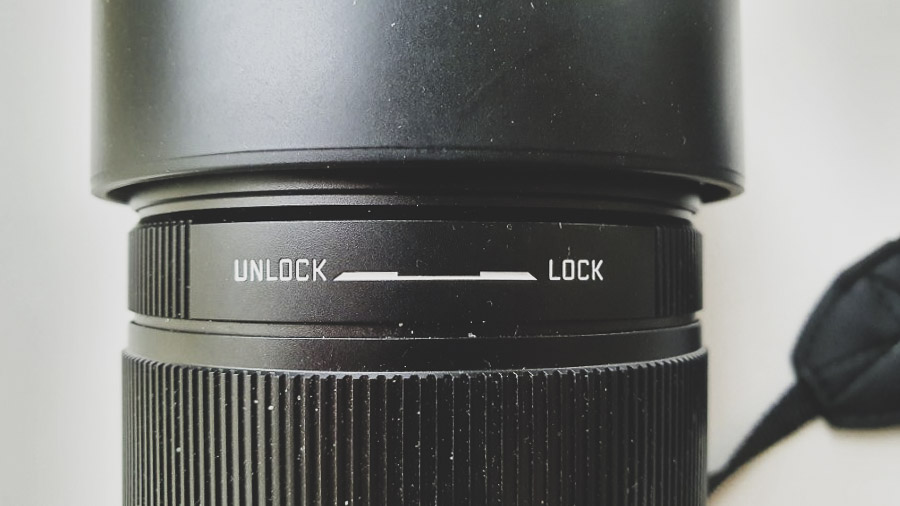
The second thing is, that I’ve experienced that even though I lock the zoom ring, I can still at times change the focal range.
For example, I might lock it at 200mm, and walk around with it like this. Then I forget about it and want to snap a quick photo at 300mm.
So I start to change the zoom, and although I feel a bit of resistance I can still manage to change the zoom before I remember that I’ve locked the lens.
Now, the lock has functioned fine while I’ve been walking around, and the focal range hasn’t changed a bit.
But I find it concerning, that I can move the extending barrel at all. And it makes me wonder if this can cause a problem down the line, and the zoom ring lock might stop functioning and I have to walk around with the lens fully extended.
Another thing is, that for the price that I’ve paid for this lens, I feel that this shouldn’t be a concern.
Weather-sealing
The weather-sealing is great and one of the things I like the most about the Panasonic GH-series.
The PanaLeica 100-400mm is splash and dustproof, so you won’t get any moisture or dust inside the lens even when you pull it out in a mild shower or on the beach.
That doesn’t mean you should go diving with it or use it in heavy rain without some kind of cover though.
Also, you need to know, that for this to fully work, it has to be mounted on a camera body that is weather sealed as well. If not, you risk water or dust sneaking in from the mount.
I’ve used this lens in light rain and heavy rain (while standing under a tree) with no problems. And aside from the dust or sand between the two barrels, I haven’t had any dust inside the lens itself.
I just hope that it isn’t possible for the sand particles to sneak in that way because if that is possible, the lens isn’t truly weather sealed. But so far no problems.
Slide on Sun Hood
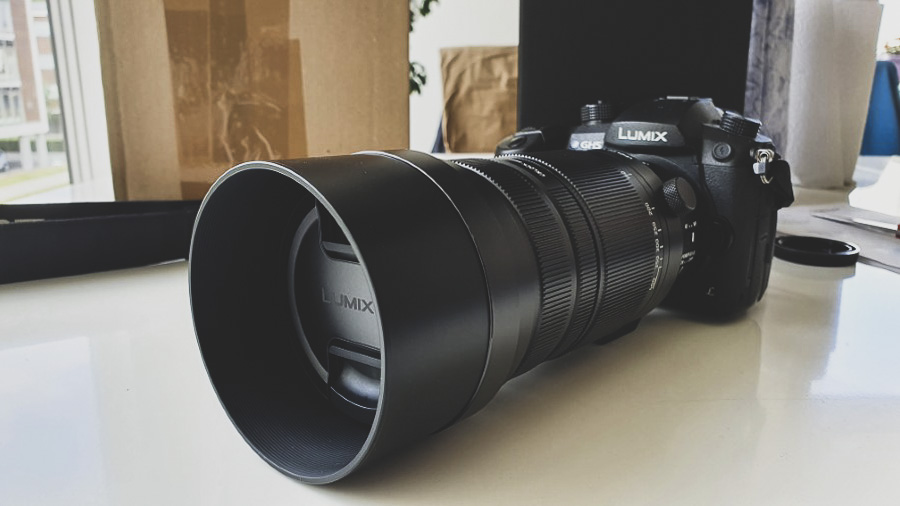
The PanaLeica 100-400mm comes with a really nice sun hood, that you simply slide on (or off). After you’ve put in place, you simply tighten a small screw on the side, and it sits there perfectly.

When you don’t need it, e.g. when traveling or for storage, you can simply flip it around, which shortens the total length of the lens.
I always walk around with this sun hood attached as extra protection against bumps and scrapes.
I prefer this solution over putting any extra protective glass on top of my lenses. In fact, generally, I find, that sun hoods make for great lens protection.
Application
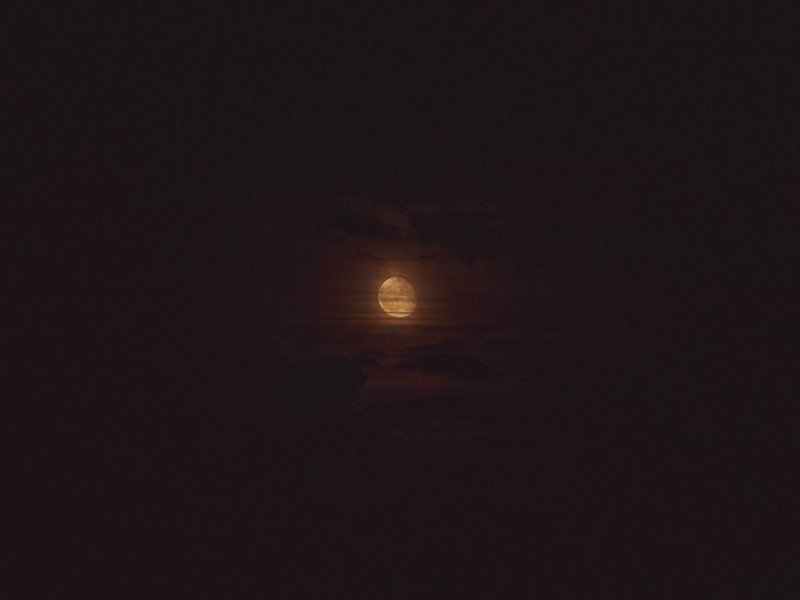
As a super telezoom, the Panasonic Leica 100-400mm is an excellent choice for wildlife photography, landscape photography, and astrophotography.
But I can also easily imagine it being used for sports photography, or for creating videos of windsurfers, surfers, or kitesurfers because of the reach.
Extending the focal range even further
If 400mm (800mm) equivalent isn’t enough for you, there are a couple of ways you can extend the range even further.
The first way is free, and that is to use the in-camera Digital Tele Conversion (DTC) function on your camera.
The second way is to buy a teleconverter you attach to the end of your lens. Let’s break it down.
Using the Digital Tele Converter (DTC) function
If you own a Panasonic or Olympus MFT camera you can use DTC to extend the range of your Leica 100-400mm even further.
The cool thing about DTC is that it is totally free, and the results you get are actually pretty good.
The way DTC works in both camera systems are slightly different from another.
Panasonic calls their version of DTC for Extra Tele Conversion (ETC).
If you own a Panasonic GH5 you can get a 1.4x increase when shooting in 4K/UHD, and a 2.7x increase if you’re shooting in FHD.
You can boost the focal range even further if you also use the digital zoom. Now, digital zoom isn’t in the same ballpark quality-wise as optical zoom, but if you need that extra boost, it’s nice to know it’s there.
For example, on my GH5, I can extend the focal range with a digital zoom of 2x or 4x.
Now, of course, the image quality would suffer a lot at those extremes, but you might be able to achieve some usable shots with more moderate settings.
Or you can choose to combine DTC/ETC with an optical teleconverter like the one below.
Using an Optical Teleconverter
There aren’t a lot of teleconverters available for the m43 system. And while you can use teleconverters designed for bigger systems, they are often big and bulky.
Even though the Lumix Leica 100-400mm lens is one of the larger native lenses for m43 it’s still a small and light lens compared to lenses designed for full-frame sensors.
So you don’t want one of those big and heavy teleconverters at the end of this lens.
A good light-weight affordable choice (from what I can read online – I haven’t tested it myself, so this is all from reading forum threads, reviews, and articles) is the Raynox HD-2200PROLE Super Telephoto Conversion Lens that extends the range with 2.2x.
It’s a front-mounted converter that you attach to the end of the Panasonic Leica 100-400mm using the filter threads (like you would attach a variable ND-filter for example).
While the optics aren’t the best, it’s a great and budget-friendly option that gives you a total focal range of 1760mm. And it’s light enough so it shouldn’t cause any problems.
Because the Panasonic Leica 100-400mm performs the best if you don’t go all the way to 400mm, you’ll get the best results at 300-350mm.
The same goes for the aperture that should be set somewhere around f/6-8 for the best results.
Alternatives to consider
There aren’t any lens on the market, that does exactly what this amazing PanaLeica does.
But if you don’t want to use this much money for a telezoom, or you simply prefer another, here are some alternatives to consider that’ll get you in the same ballpark in terms of focal length:
- Panasonic G Vario 100-300mm f/4.0-5.6 II for MFT-mount
- Sigma 100-400mm f/5-6.3 DG OS HSM for Canon EF-mount (you need an EF-to-MFT adapter or Speedbooster to use it on an MFT-system)
- Olympus 75-300mm f/4.8-6.7 II for MFT
- Olympus 300mm f/4.0 prime for MFT
Conclusion
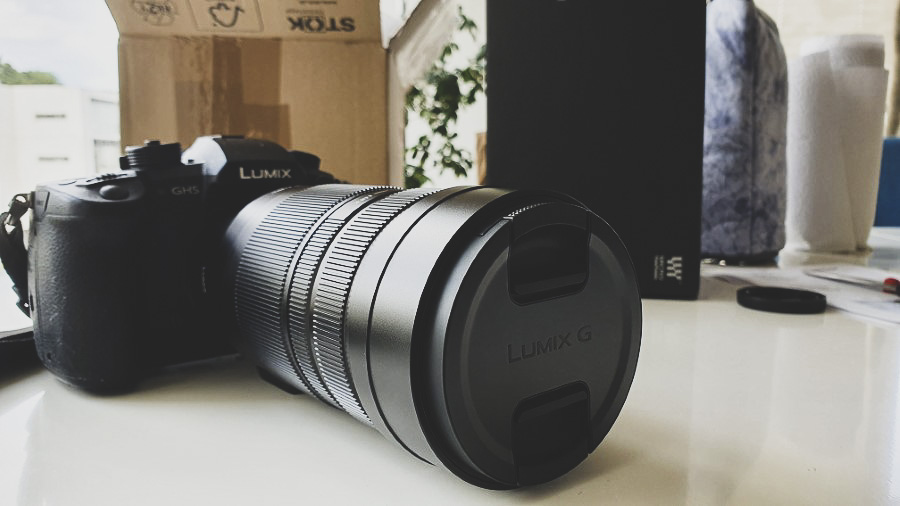
The Panasonic Leica 100-400mm is a niché lens. It’s great for wildlife photography, nature photography, sports photography, and astrophotography where you want to focus on a part of the night sky (like the moon for instance).
And because it’s a niché lens, you really need to think about whether you need this lens or not, because it doesn’t come cheap. You can check the current price here on Adorama.
But the image quality, range, and features you get the for the price do warrant the price in my opinion.
Having a range of 100-400mm does make this a very versatile super-telephoto zoom. And because of the size and weight, you can walk around with it all day.
I took it for a 20km walk one day without bringing a bagpack or sling. And though I did get a bit tired from carrying it around my neck, it wasn’t a big deal.
I’m not sure the build-quality warrants the price though, as I had not expected sand to be able to get between the barrels nor the ability to change the zoom range (albeit with a lot of resistance) when the zoom ring is in the locked position.
That being said, I really love this lens.
I had to get used to the focal range at first because I’m not used to shooting with super-telephoto zoom lenses.
When I saw something, I wanted to shoot, I had to rethink what I had to focus on, from what I would normally choose.
And I really liked that!
Suddenly, my brain had to work the same way it had to when I got my first point and shoot camera. It was like starting all over again.



Great review!
Thanks for posting.
Thank you. I’m glad you found it helpful 🙂